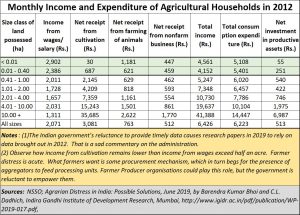https://www.freepressjournal.in/business/policy-watch-what-aatma-nirbhar-bharat-could-learn-from-the-uss-agriculture-department
Make farmers atma nirbhar. Do what the USDA does
RN Bhaskar – 28 May 2020
The Indian government should carefully study what the US has been doing if it seriously interested in Atma Nirbharta (self-reliance) of farmers.
On April 17, 2020, the United States Department of Agriculture (USDA) announced (https://www.ams.usda.gov/content/usda-purchase-3-billion-agricultural-commodities-issue-solicitations-interested) that it was exercising authority under the Families First Coronavirus Response Act to purchase from , and distribute to, those in need, up to $3 billion of agricultural products. Since media covered this announcement (https://californiaagtoday.com/usda-help-dairy-producers-big-purchase/) it is unlikely that Indian authorities are unaware of.
 Accordingly, the USDA will partner with regional and local distributors, whose workforce has been significantly impacted by the closure of many restaurants, hotels, and other food service entities, to purchase fresh produce, dairy, and meat.
Accordingly, the USDA will partner with regional and local distributors, whose workforce has been significantly impacted by the closure of many restaurants, hotels, and other food service entities, to purchase fresh produce, dairy, and meat.
It will invite proposals from farmers. farmer organisations (and the like) to supply commodity boxes to non-profit organizations, which may be identified by the supplier on a mutually agreeable, recurring, schedule.
USDA will, in turn, award contracts for the purchase of agricultural products, the assembly of commodity boxes, and delivery to identified non-profit organizations that can receive, store and distribute food items.
The Agricultural Marketing Service’s Commodity Procurement (AMSCP) program will procure each month an estimated $100 million of fresh fruit and vegetables, $100 million of dairy products, and $100 million of meat products. The distributors and wholesalers will then provide pre-approved boxes of fresh produce, dairy, and meat products to food banks, community- and faith-based organizations, and other non-profits that serve needy Americans.
Thus, the USDA aids farmers in distress through a procurement programme. Second, it aids processors and packers who may be in dire straits because of loss of business. Third, it provides food free-of-cost to needy people through non-profit organisations.
If India’s political establishment wants, it too should be doing this very thing. It should work very closely with select Farmer Producer Organisations (FPOs) in each state, offering to pick up a fixed value of agricultural produce. It could co-opt NGOs who could connect urban areas (and migrants) where people are dying of hunger, and rural food packers/producers.
Thus, instead of migrants going to ration shops managed by the Public Distribution System (PDS), NGOs would go to the needy. And instead of confining itself to the supply of free rice, wheat and (sometimes) pulses, the needy would get vegetables and dairy products as well thus enriching their nutritional basket.
The scheme has several advantages:
First, it would eliminate subsidies from being doled out. It would be a commercial proposition. The government could use procurement funds for this scheme. The farmer is then more likely to get a fair price for his produce, and save him from being distressed. Small farmers are terribly distressed (see table).
Second, it would rope in a huge army of NGOs that India has. You cannot have mass contact programmes without NGOs playing this vital role.
Third, processing units which do not get business will be assured of a regular flow of business.
Fourth, it would take in the surplus dairy production and ensure that it goes to the needy. Subsidies will not be required (http://www.asiaconverge.com/2020/04/for-milk-subsidies-is-the-path-to-perdition/ ). It gets farmers to stand on their own feet, and not cripple them with subsidies.
Fifth, it would be people friendly. Nutritious food would reach the places where the needy exist. It would prevent overcrowding at ration shops, allow for social distancing to the extent possible in slums and other crowded places
Even the USDA’s FAQs (frequently asked questions) are clear and unambiguous. For instance, the FAQs explain that the entities who will be eligible to receive food from contracted distributors would be those who provide proof to the supplier that they are tax exempt, or are government entities like schools or food authorities and who have the operational and financial capability to receive, store and distribute requested food items.
Distributors, in turn would find non-profit organisations based on existing commercial relationships that they may already enjoy with many non-profit organizations, either through direct purchases or donations.
Due audit process will ensure that each party complies with the inherent rules of doing business.
Once the contracts are awarded to distributors, USDA will supply the full list of awardees and their contact information on the Farmers to Families Food Box Program website.
Can’t this be done in India? Yes, of course, without the deleterious effects of subsidies and distribution of money to identified recipients. Given the limited numbers of parties involved in purchasing farm produce through USDA funds, an audit of such firms is possible. Thereafter, each entity does its own audit of the recipient or the distribution organisations.
The systems are simple and can be immensely effective. But that can happen only if the government actually believes in Atma Nirbhar Bharat.




































COMMENTS